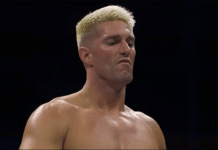Bruno Sammartino, a name renowned around the globe, was the epitome of The American Dream. An immigrant that arrived in Pittsburgh, a city known almost as much for its wrestling as the steel it once produced, as a sickly youth, grew into an international pro wrestling champion. His battles in the ring saw him go toe-to-toe with names like Superstar Billy Graham, Stan Hansen, and Ivan Koloff. His achievements of twelve years as WWWF champion and an astounding 187 sellouts of the world’s most famous arena, Madison Square Garden, provided the foundation of what ultimately morphed into the global entertainment brand of WWE today. As such, his career inside the ring ropes, a tenure that spanned almost three decades, was rightfully given a featured spotlight, especially since his induction in the WWE Hall of Fame in 2013, which gave an entirely new generation a look at the golden age of the WWWF.
After that induction, where Arnold Schwarzenegger was the presenter for the honors to the Italian strongman, the world was reintroduced to what his adopted hometown of Pittsburgh already knew, Bruno was pro wrestling’s most honorable champion.
But how did the youngster that almost died before he reached America survive such dangerous times in the midst of World War II? It turns out that while his triumphs on the canvas brought thousands of fans to their feet, his childhood in his native Italy was the toughest battle of his life.
Earlier this week, I received a text from the great Pat Maclaughlin, a mentor that has helped me a lot and someone that I’m always thankful for, to let me know that a new documentary on Bruno’s life was set to premiere at the Heniz History Center, a massive museum with more artifacts and items on display than I have time to mention here, but can definitely recommend to anyone in the Pittsburgh area. After getting the green light from the Vince McMahon of the family, Mrs. Mac, Pat was as enthusiastic as I was about the new feature-length film on the iconic champion. We arrived at the venue about 40 minutes before the presentation was set to begin and were told that the museum was open to us. We wandered around the sports section for about 25 minutes, which still only gave us enough time to scratch the surface to see the incredible amount of memorabilia on display before we went to the location of the screening.
I was surprised to see Larry Richert, a longtime member of the Pittsburgh media, in attendance, but soon learned that he was one of the driving forces behind the completion of the project on the iconic wrestler’s life. I have to say, the set up was very classy, with a nice background that was illuminated by red and green lights to represent Bruno’s beginning in Italy. With Sammartino such an institution of the region, many older folks were dressed in formal attire and the atmosphere felt like it fit an occasion for Bruno. I’ll admit, I felt slightly under dressed with my throwback Jack Lambert jersey and jeans, but a very polite lady in front of us complimented me on the retro attire. I also must point out that Richert, a longtime friend of the late Sammartino, sounded so genuine in his admiration and appreciation for Bruno. Also in attendance were Pittsburgh natives, Sam Adonis and Corey Graves with their family. A quick side note that I want to mention, when Adonis and Graves’ father, Dan Polinsky promoted independent cards, Sam arranged for me to help get my start on the local scene as a commentator for events more than a decade ago. I’m still an announcer on the local scene today, but it was the kindness of the Polinsky family that allowed me to get a solid start. ECW legend, Shane Douglas was also spotted, which gave this viewing a vibe of just how much respect the Sammartino name carries in Pittsburgh.
Thank you Darryl, Sam, Corey and Bruno Sammartino fans everywhere! The @HistoryCenter did a tremendous job saluting Italian-American Immigrants and all those who battled to get to this country. https://t.co/DpvPIglxGB @WWE @Azzurri @KDKALarry @AP https://t.co/4k5cuv0nPp
— Larry Richert (@KDKALarry) October 7, 2022
As the lights dimmed, “Bruno Sammartino:The Authorized Biography of Wrestling’s Greatest Champion” hit the screen. The biggest takeaway and the most unique aspect of this particular feature is that it dives into the one aspect of Bruno’s life that countless other productions glossed over simply because his professional achievements were so monumental, his struggle to survive as he hid from the Nazi invasion of his village. This production finally puts the spotlight front and center on a tale that proves that truth is stranger than fiction. Hollywood couldn’t write a script for the unimaginable things that the Sammartino family endured as their fled for their lives on multiple occasions, hiding in the mountains for the Nazis.
You’re invited to a very special evening at the Heinz History Center Thursday October 6th, a screening of “Bruno Sammartino” the Authorized Biography of Wrestling’s Greatest Champion”! @PittsburghPG @TribLIVE @AP @WWE @Schwarzenegger @JohnCena https://t.co/QQXXVqYG7I
— Larry Richert (@KDKALarry) October 5, 2022
After Bruno’s father immigrated to Pittsburgh, where he intended to bring his family after he saved enough money, travel was closed off during World War II. The harrowing tale of Bruno, his siblings, and his mother fleeing into the mountains when the Nazis invaded their town is something that you must hear from those that were there to truly understand the magnitude of just how dangerous it was. Bruno recounted the many, many times that his mother climbed down the mountain to sneak into their home, where the Nazis stayed during the invasion, to steal food for her children. She climbed back up the mountain, and you will hear recollections from Bruno’s brother and sister of how they wondered if their mother would return safely. During one of her many climbs down the mountain, Mrs. Sammartino was captured by the Germans, but escaped before she was shot in the shoulder. Bleeding from a gunshot wound, she made the climb back up the mountain to reach her children.
The gravity of just how devastating this was can be seen when the documentary followed Bruno back to his hometown in Italy, where he was honored in 2010. The Italian strongman that was as tough as the steel of Pittsburgh, wept as he recounted when his mother returned injured. Amazingly, during that visit home in 2010, Bruno climbed the same mountain that his mother climbed all those times to provide some food for her children. When food wasn’t there, they ate snow to survive.
Eventually, the Sammartino family joined their father during the post-war era in Pittsburgh, and Bruno’s path to the well-known global stardom began as he built his body from nearly nothing to strongman champion after he started training at the local YCMA. Clips of his memorable wrestling career, including his WWE Hall of Fame induction were included, as the documentary was produced with the association of the WWE. During his pre-show comments, Richert gave a special thanks to Triple H. After the film wrapped, Bruno’s son, Darrel took a few questions from the audience, and in recognition of Bruno’s birthday, guests were offered some cake.
The biggest takeaway from this film was ultimately family. Ironically, that’s how the Sammartino name became so ingrained into the fabric of Pittsburgh. The blue collar fans identified with Bruno and then the stories of his greatness were passed down through the generations. The wonderful late Grandma LaMotta was full-bloodied, and the legendary late Grandpa LaMotta was a WWII veteran that worked in the steel mills as a crane operator for over thirty years before his retirement. For as long as I can remember, I’ve been a wrestling fan, and from my earliest years, my dad told me the stories of Bruno being, THE champion of wrestling. Thankfully, I had the chance to meet Bruno on two occasions, once when I was only seven and then again when I was 16, both times he was such a gentleman. Many others in attendance at the screening shared similar stories of their interactions with him.
Larry Richert mentioned that the film would be available on streaming platforms, and I completely recommend this documentary. Bruno was an honorable champion and this feature explains where his life started before he became a global star.
What do you think? Share your thoughts, opinions, feedback, and anything else that was raised on Twitter @PWMania and Facebook.com/PWMania.
Until next week
-Jim LaMotta
E mail [email protected] | You can follow me on Twitter @jimlamotta







